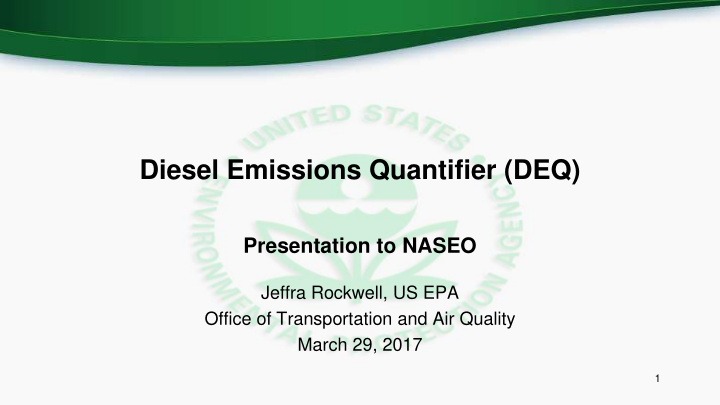



Diesel Emissions Quantifier (DEQ) Presentation to NASEO Jeffra Rockwell, US EPA Office of Transportation and Air Quality March 29, 2017 1
What is DEQ? • Estimator for evaluating clean diesel projects and upgrade options for medium-heavy and heavy-heavy duty diesel engines • Interactive, web-based tool for users without modeling experience • New release coming in April 2017 2
What DEQ Does • Assesses onroad, nonroad, locomotive and marine projects • Accepts user-specific inputs for engine specs and usage • Allows for multiple upgrades (emission control devices, idle reduction, replacements, alternative fuels, etc.) • Provides annual and lifetime estimates for – Baseline emissions (in short tons) – Reduced emissions (in short tons and % of baseline) – Cost effectiveness (total project and/or capital costs) – PM related health benefits (needs updating) 3
What DEQ Doesn’t Do • Does not estimate – Emissions from C3 marine engines – GHG reductions except for CO 2 when fuel usage is reduced – Offsets for emissions from power plants – Black carbon emissions – Health benefits from NOx, HC and CO reductions • Cannot be used for SIPs or Conformity 4
How DEQ works • For engine or vehicle replacements: DEQ estimates emissions from both the old and new engines. The difference is the estimated emission reduction resulting from the replacement. • For other upgrades (emission controls, idle reduction, etc.): DEQ applies EPA or CARB verified emission reduction factors to the baseline emissions. The result is the estimated emission reduction from the upgrade. 5
Assumptions in DEQ • CNG, LNG and LPG engine/vehicle replacements use diesel criteria pollutant factors as a surrogates. – No good data source for alternative fuel & engine factors – Alternative fuel engines must meet diesel standards – Converts alternate fuel to diesel-equivalent gallons for CO 2 • Median life is used in estimating lifetime reductions; this may be edited, but the value is capped. • For nonroad, locomotive and marine, assigns baseline engine year or tier when only one of these is entered. 6
Data sources for DEQ • Onroad – MOVES2014a (in-use data) • Nonroad – Factors & formulas from the NONROAD model – EPA regulatory documents • Locomotive – EPA regulatory documents • Marine – EPA regulatory documents • Emission reductions from EPA and CARB verification and certification programs 7
Strengths of DEQ • Easy to use • Projects can be saved for later editing and review • Inputs and results are downloadable in Excel format • Historic baseline data – Onroad beginning 1985 – Nonroad, locomotive and marine beginning 1973 • Specific emission factors for running, duty-cycle idling & hoteling for onroad vehicles • Duty-cycle specific factors for line haul locomotives 8
Limitations of DEQ • No NOx reduction with switch from ULSD to alternative fuel (may see reductions from newer engine or other upgrade) – Uses ULSD factors for criteria pollutants – Have factors for B5 and B20 for onroad vehicles • No offset of power plant emissions for electric engine/vehicle replacements or electrified parking spots • Health benefits module needs updating 9
Create New Project – onroad, nonroad or locomotive 10
Add Vehicle or Engine Group – onroad, nonroad or locomotive 11
Define a Vehicle Group - onroad 12
Define a Vehicle Group – nonroad and locomotive 13
Add an Upgrade – onroad, nonroad or locomotive 14
Add an Upgrade - onroad 15
Add an Upgrade – nonroad and locomotive 16
Create New Project – marine 17
Add Engine Group – marine 18
Define an Engine Group - marine 19
Emission Results 20
Cost Effectiveness 21
Health Benefits 22
Health Benefit Results 23
For More Information DEQ website www.epa.gov/cleandiesel/diesel-emissions-quantifier-deq ~~~ Questions about DEQ or the DERA option cleandiesel@epa.gov 877-623-2322 24
Recommend
More recommend